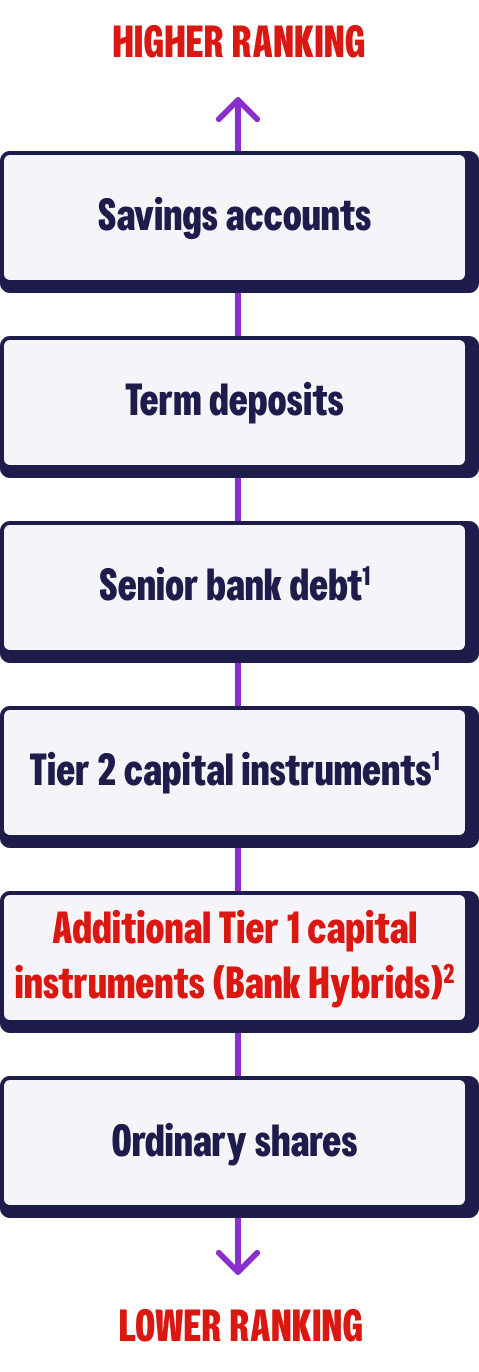Investing in Australian Banks

1. Generally only available to wholesale investors
2. Also called capital notes or convertible preference shares
Comparing Australian Bank Hybrids to other Australian bank investments
Bank Hybrids differ from other bank investments in terms of their features and risks. The table below outlines the different investment options in Australian banks, such as Westpac, some of their key features.
| Investment type | Legal Form | Government Guarantee and Statutory Protection | Typical Term |
|---|---|---|---|
| Savings account | Deposit | Subject to a limit per account holder per ADI of $250,000. |
At call |
| Term deposit | Deposit | Subject to a limit per account holder per ADI of $250,000. |
Fixed term, 1 month to 5 years |
| Tier 2 capital instrument | Unsecured subordinated debt obligation | Fixed term, greater than 5 years | |
| Bank Hybrid | Unsecured subordinated debt obligation or preference share | Perpetual | |
| Ordinary share | Ordinary share | Perpetual |
Assessing the strength of a bank
The risk of an investor losing some or all of their investment in Bank Hybrids depends on, amongst other things, the financial strength of the issuing bank. The stronger the bank, the less risk there is of an investor losing some or all of their investment.
The table below lists a number of key measures that may be used to assess the strength of a bank (this table is not an exhaustive list).
Capital levels
- Capital underpins the strength of a bank
- Strong capital levels provide a buffer to absorb losses on a bank’s assets or if the bank experiences financial difficulty
- In the event a bank becomes non-viable, Bank Hybrids may be converted into ordinary shares or written-off
- Higher capital may indicate a lower likelihood that the bank will fail or become non-viable and may reduce the likelihood of Bank Hybrids being converted into ordinary shares or written-off
Profitability and earnings
- A profitable bank is better placed to continue to meet its obligations, including paying interest, distributions and dividends
- Strong profitability allows a bank to generate capital and improve its common equity tier 1 capital ratio
Loan portfolio quality
- The quality of a bank’s assets (for example, home loans) is important to its financial strength
- If a bank lends to higher risk individuals / higher risk companies, it may incur higher bad debts, which in turn may impact profitability and capital
- Significantly higher risk activities, or operating in higher risk markets, may pose additional threats to long term profitability and capital position
Funding and liquidity
- Access to funding is important so that a bank may continue lending activities and may repay obligations (including deposits)
- Strong liquidity management and liquidity levels may indicate a lower likelihood of a bank becoming insolvent or non-viable
External influences
- External influences may impact the operating environment and economic conditions including interest rates, employment levels, business activity and consumer sentiment
- A strong regulatory environment may contribute to a bank’s ability to remain viable and meet its commitments, including paying interest or distributions and repaying principal on Bank Hybrids
- A strong economy is generally good for banks
Capital levels
- Common equity tier 1 capital ratio
- Tier 1 capital ratio
- Total capital ratio
Profitability and earnings
- Net profit after tax
- Expense to income ratio
- Return on equity
- Earnings per share
Loan portfolio quality
- Loan impairments
- Bad and doubtful debt provisioning
- Provisioning coverage ratios
Funding and liquidity
- Net stable funding ratio
- Liquidity coverage ratio
External influences
- The country’s economic, fiscal and monetary policies
- Strength of the regulators
Where to find performance-related information for Australian banks
Listed Australian banks report their performance to the market at least every six months on the ASX. This information is also generally available on a bank’s website.
Information provided to the ASX includes:
- Financial results announcements;
- Investor presentations;
- Annual reports; and
- Pillar 3 reports (providing detailed information on a bank’s capital, risks and loan portfolio quality.
Westpac’s financial results, including results announcements and annual reports, may be found here.
Things you should know
This Guide only looks at some of these features and risks. It does not provide investment advice and cannot address your individual circumstances, objectives or needs. Prior to investing in Bank Hybrids you should ensure that you understand the features and risks. You should read the relevant prospectus carefully, paying attention to the investment risks. If you need further information, you should seek professional guidance from your stockbroker, solicitor, accountant or other independent and qualified professional adviser.